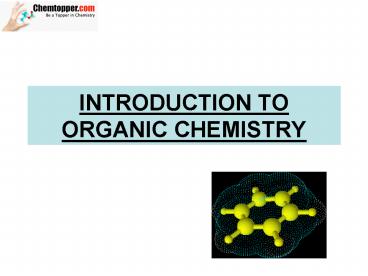INTRODUCTION TO ORGANIC CHEMISTRY PowerPoint PPT Presentation
1 / 9
Title: INTRODUCTION TO ORGANIC CHEMISTRY
1
INTRODUCTION TO ORGANIC CHEMISTRY
2
ORGANIC CHEMISTRY- chemistry of Compounds
derived from animals and Plants(before 1828)
Cyclohexane-C6H12
Now a- days organic chemistry is defined as the
chemistry of carbon Compounds or the chemistry
of hydrocarbons and their derivatives
Benzene-C6H6
3
Vital force theory
(prominent idea of the 1700s)
Cyclopentane-C5H10
Brazelius proposed vital force theory Vitalism
was the belief that certain chemicals,
ORGANIC CHEMICALS, could only be made by living
organisms and could never be synthesized by man.
INORGANIC CHEMICALS
were found primarily in the earth as
mineral deposits, but could also be prepared by
man.
4
Friedrich Wohler (German), 1828 synthesized the
first organic molecule
..
Synthesis of Urea (organic) from Ammonium
cyanate (inorganic)
organic
inorganic
First blow on vital force theory ..
Structure of urea-NH2CONH2
5
ORGANIC CHEMISTRY TODAY
C
H
N
O
F
B
P
S
Cl
Si
Br
chemistry of the covalent compounds of carbon or
chemistry of hydrocarbons and their derivatives.
I
Compounds of hydrogen and carbon are called as
hydrocarbons Derivatives when combined with a
few other common elements
(H B N O Si P S F Cl Br I )
Methane CH4
6
why only carbon?
Because carbon is unique .
6C
7
UNIQUE PROPERTIES OF CARBON
1)Carbon is TETRAVALENT and can form 4 bonds
by sharing electrons i.e covalent bonds
2)Catenation-the tendency of atoms of an element
to unite with each other forming a chain of
covalent bonds is known as CATENATION .
CH3-CH2-CH2-CH2-CH2-CH2-CH2-CH2-CH2-CH3
Decane-C10H22
8
- Carbon possesses maximum tendency for catenation.
- Reason---bond energy for catenation of C is
maximum. - C-C Si-Si
N-N P-P O-O S-S - Bond Energy 85 54 39 50
35 54 - (Kcal /mole)
- High Bond energy high stability high tendency
of CATENATION. - CgtSiSgtPgtNgtO(Catenation order)
Carbon can also form BRANCHED NETWORKS and
RINGS
9
3) Carbon also forms double as well as triple
bonds.
THE DIVERSITY OF CARBON
4)THE DIVERSITY OF CARBON Because of catenation
and branching
MILLIONS of organic compounds are known
The great diversity of carbon compounds
makes carbon a natural element on which to base
complicated LIVING SYSTEMS
"Imagination is more important than knowledge"
- Albert Einstein

